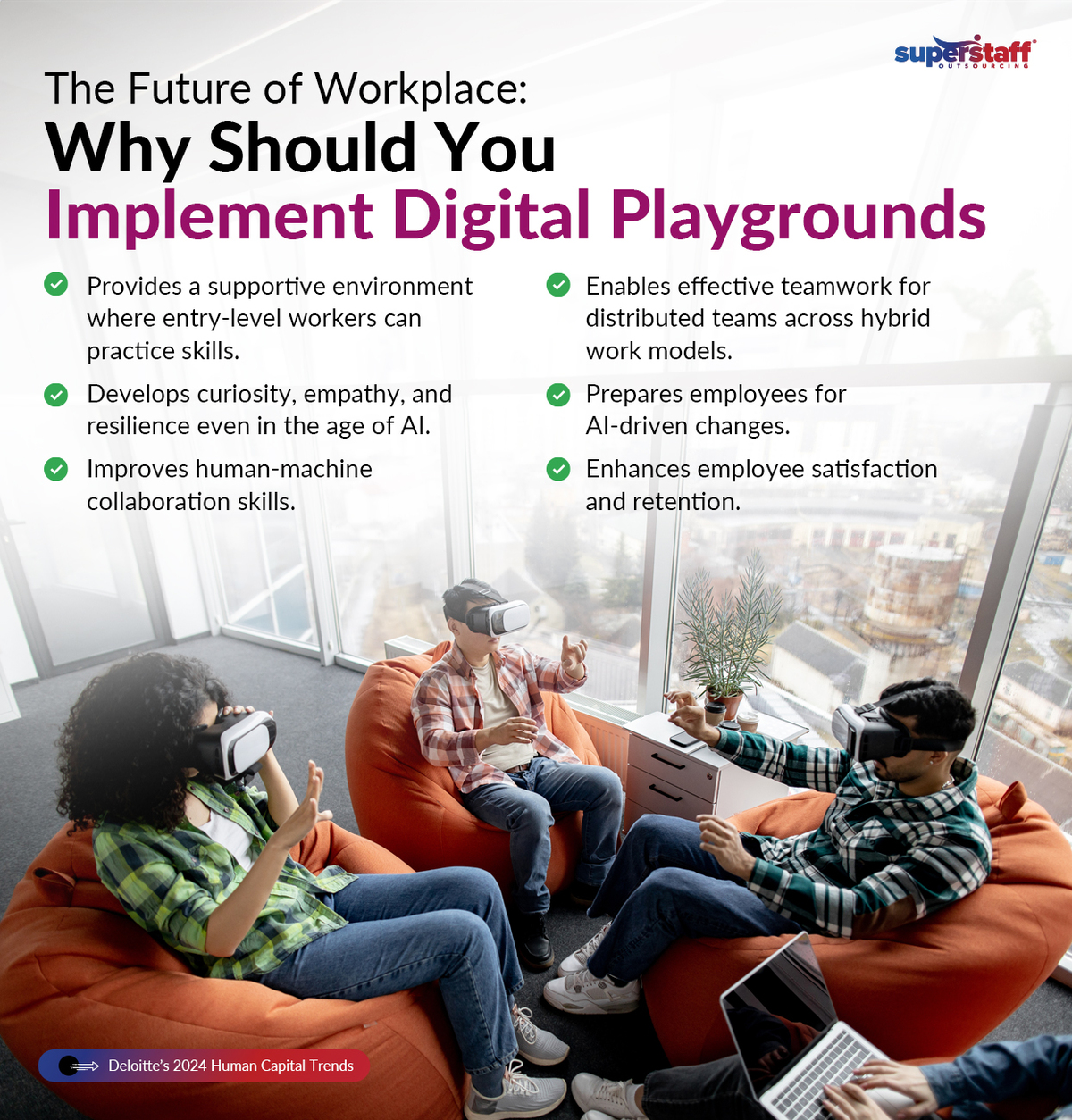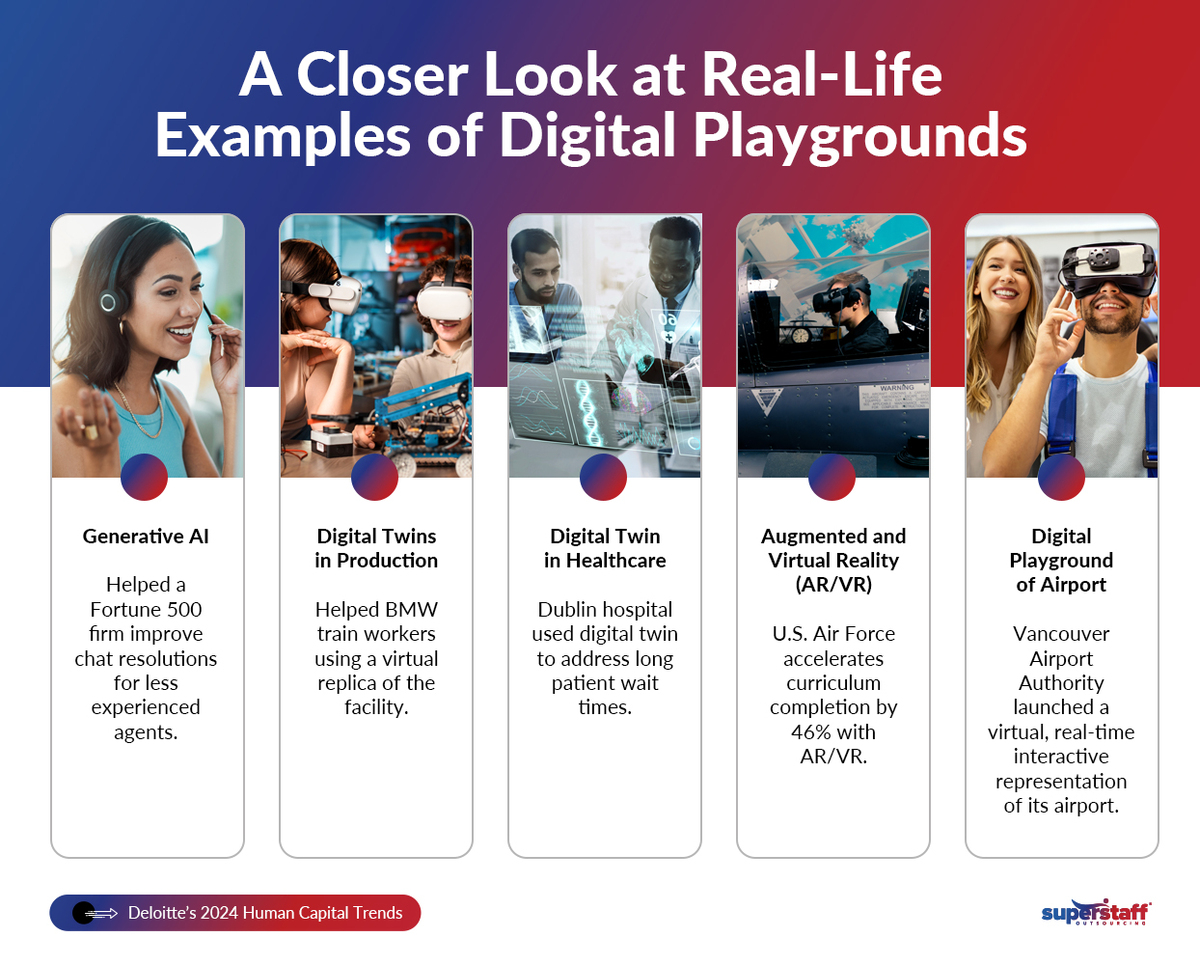
The future of work is here. It’s digital, boundless, and ever-evolving.
Imagine a playground for children: a vibrant, immersive, and collaborative environment where learning is inherently enjoyable. This is the essence of a digital playground for the workplace.
As Deloitte describes in its 2024 Human Capital Trends report, the digital playground is more than just a physical space or a virtual platform. Instead, it’s a mindset, a culture in which technologies are democratized. It’s a safe space for workers to build confidence, learn new skills, and hone their human capabilities.
Understanding Digital Playgrounds
In its report, Deloitte pointed out the growing need for safe spaces where employees can work together and create their future work amid the AI revolution. This is where the digital playground concept comes in.
The operative word is PLAY. When we think of ‘work,’ it often feels like there’s just one right way to do things, which can be stressful. But play is different. It allows us to explore, experiment, and collaborate.
In a digital playground, gamified learning modules, interactive simulations, and engaging content transform mundane training into exciting experiences. It is also a place for experimentation and learning from mistakes through trial and error. Employees are encouraged to take risks, explore new ideas, and innovate at their own pace. Workers can interact, share ideas, and develop solutions together.
This revolutionary concept leverages collaboration tools like virtual workspaces, shared documents, and communication platforms to facilitate seamless teamwork — breaking down silos, promoting diverse perspectives, and driving collective problem-solving.
Digital playgrounds also promote immersive learning with hands-on, practical, experiential activities that are engaging and memorable. Through the use of virtual reality (VR), augmented reality (AR), and other immersive technologies, employees can experience realistic simulations and scenarios.
Key Factors Driving the Need for Digital Playgrounds
According to Deloitte, 82% of workers say it’s important that their company helps them imagine how their jobs may change. Yet, only less than half (43%) do so.
For instance, only 13% of workers had been offered AI-related skills training in the past year, despite a majority believing these skills would be essential to their prospects. Meanwhile, AI demand continues to soar:
- 64% of businesses believe AI will increase overall productivity.
- Generative AI use has doubled recently, with 75% of global knowledge workers using it.
- Time Savings: 90% of users report that AI helps them save time.
- Enhanced Focus: 85% say AI enables them to concentrate on their most important work.
- Increased Creativity: 84% feel more creative when using AI.
- Improved Job Satisfaction: 83% enjoy their work more thanks to AI
As AI becomes increasingly integral to business operations, the need for digital playgrounds in the workplace has never been more critical.
Let’s take a closer look at the significant factors fueling the need for such spaces in the workplace.
The Power of Play: Advantages of a Digital Playground

Provides a Supportive Environment Where Entry-Level Workers Can Hone Skills
While the AI age holds great promise for the future of work, it also has its downsides.
Automation is reducing entry-level positions, making more advanced skills even more critical. This shift will be especially tough on younger people just starting their careers. Fortunately, digital playgrounds can help by offering a safe and supportive space for them to build these essential skills.
Develops Curiosity, Empathy, and Resilience Even in the AI Age
The ability to adapt and grow isn’t just about mastering new tools and software — it’s about nurturing the fundamental human qualities that drive innovation and collaboration.
Curiosity is the engine of innovation. It drives us to question, seek new knowledge, and explore uncharted territories. Digital playgrounds are designed to be interactive and engaging, sparking employees’ natural curiosity. Imagine a virtual environment where team members can tinker with AI algorithms, explore virtual replicas of their workspaces, or experiment with new digital tools without the fear of making mistakes.
In an increasingly connected world, empathy is just as important. For example, virtual reality (VR) scenarios can place employees in the shoes of their customers, colleagues, or even those from different cultural or socioeconomic backgrounds. This helps build a deeper understanding and appreciation of others’ challenges and viewpoints. As a result, employees become better collaborators, more considerate teammates, and more effective communicators, essential for building strong, cohesive teams.
Meanwhile, resilience empowers employees to bounce back from setbacks and persevere in facing challenges. Digital playgrounds provide a safe space where employees can experiment, fail, and try again without fearing real-world consequences. This trial-and-error approach teaches resilience as employees learn to view failures as learning opportunities rather than setbacks. Engaging in playful, low-stakes experimentation helps them develop the mental toughness needed to navigate the uncertainties and pressures of the modern workplace.
Improves Human-Machine Collaboration Skills
As smart technologies reshape work processes, the ability to collaborate effectively with these technologies is essential. Digital playgrounds allow workers to experiment and improve human-machine collaboration skills, ensuring they can seamlessly integrate AI and other advanced tools into their workflows.
Digital playgrounds are controlled environments where new technologies can be tested and refined. For instance, integrating IoT tools through these platforms improves traffic control, worker safety, and carbon emission reduction for industries like shipping, construction, and natural resources.
Enable Effective Teamwork for Distributed Teams Across Hybrid Work Models
Upwork predicts that nearly a quarter of the American workforce will work at home next year. What was once a perk has become a fundamental aspect of modern business operations. This shift has shown that teams can thrive outside traditional office settings, often achieving equal or greater productivity than in-office environments.
However, the transition to remote work won’t be without its challenges. One of the biggest hurdles is ensuring effective communication and collaboration across distributed teams. When you’re not in the same physical space, it’s easy to feel disconnected or miss out on important updates.
Digital playgrounds will be a massive help in this transitional stage.
These tools are lifelines for remote teams, offering a range of interactive features that mimic the office environment. Imagine hopping into a virtual meeting room where you can brainstorm ideas on a digital whiteboard or collaborate on a project in real time, all from the comfort of your home office. This level of immersion helps bridge the gap between team members scattered across different locations and time zones.
As more companies embrace hybrid work models — mixing remote and in-office days — digital playgrounds will maintain team cohesion and productivity. They’re essential tools for overcoming remote work’s communication and collaboration barriers, helping teams stay connected and focused on achieving their goals.
Prepare Employees for AI-driven Changes
The push towards AI adoption is unmistakable.
Deloitte reports that 75% of organizations globally plan to accelerate their use of AI within the next five years. Employees, too, see AI as a catalyst for career advancement, with 52% believing it enhances their professional prospects. However, despite these aspirations, only 43% feel adequately prepared by their organizations for AI-driven changes, revealing a significant readiness gap in workforce training.
While AI advancements promise efficiency gains, they also evoke concerns about job displacement and misinformation. Studies indicate that over 75% of consumers worry about AI-driven misinformation, and projections suggest AI could replace a significant portion of the global workforce.
This is where digital playgrounds come into play. By providing hands-on experiences and simulations, digital playgrounds allow employees to familiarize themselves with AI technologies in a safe, controlled setting. This empowers them to learn about using AI tools effectively, understand their implications, and explore innovative applications without fearing real-world consequences.
Enhances Employee Satisfaction and Retention
Contrary to conventional beliefs, integrating play into work environments enhances employee satisfaction and retention.
Organizations like Salesforce, known for their inclusive and playful cultures, consistently report high employee satisfaction and low turnover rates. Engaged employees are more likely to stay committed to their roles, contributing positively to organizational performance and culture.
Real-Life Examples of Tech Where Digital Playgrounds Is Implemented

Digital playgrounds are revolutionizing industries by harnessing innovative technologies for training, skill development, and operational efficiency. Here, we explore compelling examples of tech where digital playgrounds are making a significant impact:
Generative AI
A Fortune 500 software firm deployed generative AI to enhance customer service. The AI provided real-time suggestions, improving chat resolutions by 14% overall and 35% for less experienced agents. This application showcases how AI can streamline operations and elevate service quality in real-time interactions.
Digital Twins in Production
BMW utilized digital twins to revolutionize training at a new production plant.
By creating a virtual replica of the facility, workers could familiarize themselves with the environment and practice operational skills without the risk of real-world mistakes. This approach exemplifies how digital twins optimize workforce readiness and operational efficiency in complex industrial settings.
Digital Twin in Healthcare
In Dublin, Ireland, a leading private hospital faced challenges such as long patient wait times and operational inefficiencies. The hospital implemented a digital twin of its radiology department to address these issues.
This virtual 3D environment allowed teams to experiment with different layouts and operational scenarios, reducing patient waiting times by up to 25 minutes and overall turnaround times by 28 minutes. Such rapid improvements demonstrate the transformative potential of digital twins in healthcare settings.
Augmented and Virtual Reality (AR/VR)
The U.S. Air Force adopted AR/VR technologies for training, significantly enhancing safety and accelerating curriculum completion by 46%. This use case illustrates how AR/VR simulations can simulate real-world scenarios, providing immersive learning experiences that boost operational readiness and efficiency.
Vancouver Airport Authority’s Digital Playground
The Vancouver Airport Authority launched a virtual, real-time interactive representation of Vancouver International Airport (YVR) in 2022.
This platform integrates virtual spaces with real-time data from IoT sensors throughout the facility. It is a digital playground for experimentation, enabling stakeholders to explore innovative uses for data-driven decision-making and collaboration. From managing ground traffic control to improving worker safety and reducing carbon emissions, this initiative highlights the broad applications of digital playground technologies in optimizing airport operations and fostering community innovation.
Digital Playground: Cutting-Edge Tech + Human Excellence Workplace Trend
From innovative remote work strategies to cutting-edge technologies revolutionizing industry standards, SuperStaff provides expert insights to help you navigate the evolving dynamics of modern work environments.
Stay ahead with our insightful updates on workplace trends and work-life balance initiatives. Follow our blog for the latest strategies shaping today’s dynamic business landscape. Don’t miss out!






